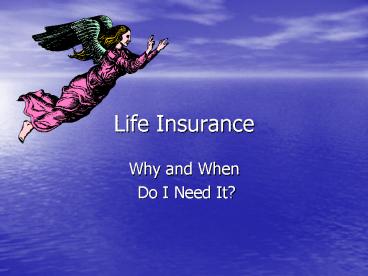Life Insurance - PowerPoint PPT Presentation
1 / 11
Title:
Life Insurance
Description:
Life insurance covers your expenses such as funeral and medical bills. ... Medical Exams? Why do life insurance. companies generally require. medical exams? ... – PowerPoint PPT presentation
Number of Views:42
Avg rating:3.0/5.0
Title: Life Insurance
1
Life Insurance
- Why and When
- Do I Need It?
2
Life Insurance
- Life insurance is a contract that pays a
beneficiary in the event of your death as long as
the policy is in effect. - Life insurance is something you buy for those
people you leave behind. Life insurance covers
your expenses such as funeral and medical bills.
You may also need to leave financial support to
your family.
3
Who Needs It?
- If your
- Single - Consider life insurance for retirement
and estate planning. And if youre young and
healthy, now may be the best time to lock in a
low rate. - Married or Getting Married - You are not in this
alone anymore. Your spouse depends on you in lots
of ways. Losing you to an accident or illness
would be a huge emotional loss for them. Having
the right amount of life insurance can help make
sure its not a huge financial loss as well.
Isnt it important to help secure your familys
future? - Buying A Home - Buying a home is one of the
biggest purchases you may ever make. Did you know
that life insurance can be used to help pay off
your mortgage and keep your family in their home
should something happen to you?
4
Types of Life Insurance
- Basically there are 2 types of life insurance
- Term
- and
- Whole Life
5
Term Life Insurance
- Term Insurance The most basic and least
expensive type of life insurance. You buy
coverage for a certain amount of time, such as
10, 15, 20 or 30 years. If you die before the
term is over, your beneficiary gets the benefit
stated in your policy. If you live beyond the
term, the policy expires. - Therefore, if you purchase a 30 year term
policy at the age of 20 you will not have any
life insurance beyond the age of 50
6
Whole Life Insurance
- Whole life or Permanent Insurance This type of
policy never expires. As long as premiums are
paid, it remains in force. Premiums are usually
based on your age at the time of purchase and
generally remain level. In addition to providing
a death benefit, premiums are also invested to
produce returns adding cash value to your
policy. There are three major types of whole life
or permanent life insurance traditional whole
life, universal life, and variable universal life.
7
Types of Whole Life
- Traditional Whole Life You'll pay the same amount
of premium for the rest of your life. (Start
young and the less expensive the premiums will
be.) Your cash value will accumulate based on a
guaranteed rate. As long as your policy is
current, you can borrow against the cash value at
the current policy loan interest rate. - Universal Life gives you more flexibility. You
pay a set initial premium, but after that, you
decide when and how much you want to pay. How
does this work? The insurance company simply
charges the insurance cost from your cash value
account. - Variable Universal LifeThis insurance combines
some features of policies to create a more
flexible life insurance product. As with
universal life policies, you decide, after the
initial premium, when and how much more you want
to pay into your policy. You can adjust the death
benefit, plus you have the wide range of
investment options. Your cash value will
increase or decrease, depending on the
performance of the underlying funds.
8
Filing a Claim
- Unfortunately, someday you may
- responsible for dealing with the
- loss of a loved one.
- What are the four steps in filing a claim?
- 1. Obtain several copies of the death
certificate. - 2. Contact your insurance agent.
- 3. Submit a certified copy of the death
certificate (or acceptable alternative in
extraordinary circumstances) from the funeral
director with the policy claim. - 4. Once a life insurance claim is submitted, you
will need to determine how the proceeds will be
distributed.
9
Settlement Options
- In some cases there are four settlement options
- Lump sum You receive the entire death benefit in
a single amount, which allows you to use what you
need for immediate expenses and invest the rest. - Specific income provision The life insurance
company pays you both principal and interest on a
predetermined schedule. - Life income option You receive a guaranteed
income for life. The amount of income depends on
the death benefit specified in the life insurance
policy, your gender, and your age at the time of
the insured's death. - Interest income option The company holds onto
the proceeds and pays you interest. The death
benefit remains intact and goes to a secondary
beneficiary upon your death.
10
Medical Exams?
- Why do life insurance
- companies generally require
- medical exams?
- You will be classified based on age, height,
weight, nicotine use and other health factors,
such as any history of high blood pressure or
depression. Your health status will determine
what rate class category you fit in, so even if
you have some health problems, you could be
covered.
11
Rating Class
- The rating class that you fit into will determine
the price you pay in premiums. - As you can guess, a smoker
- will pay a higher premium than
- a non-smoker and an over-weight
- person will pay more than a thin person.
- Buying insurance when you are younger, healthier
and a non-smoker will save you money in many ways.































